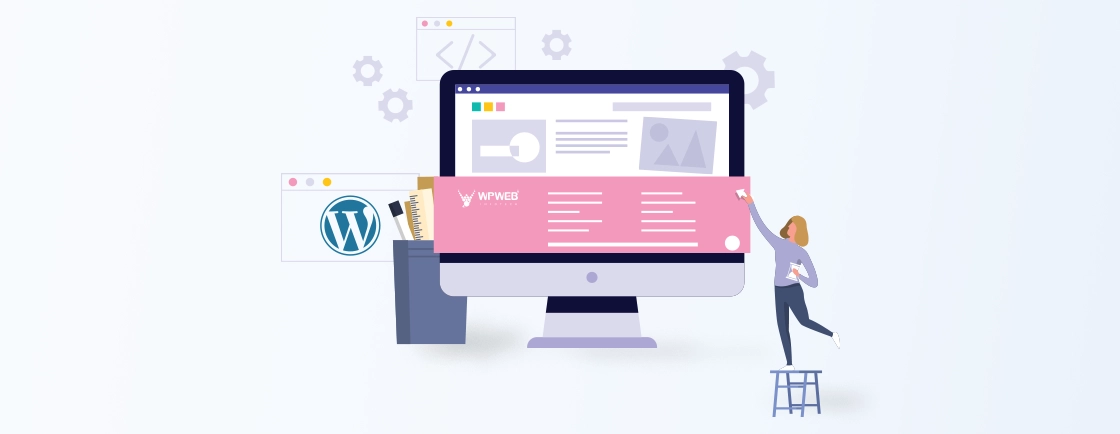Table of Contents
Nowadays, attention spans have become shorter than ever, so captivating them through just static information is likely to lose visitors quickly. That’s why incorporating interactive elements is crucial. Scroll over elements, in particular, offer a dynamic and subtle way to add depth and intrigue to your WordPress website.
Creating scroll over interactive elements in WordPress is easier than you might think. There are a few different techniques, from using plugins with user-friendly interfaces to implementing custom CSS for more tailored effects.
Let’s see how the process goes. But before that, we will discuss what the scroll over elements are.
What are Scroll Over Interactive Elements?
Scroll over interactive elements are features on a website that respond to the user’s mouse cursor hovering over them. They add a dynamic layer to your web pages, making them more engaging and interesting for visitors.
Imagine moving your mouse cursor across a webpage. As it passes over certain elements (like images, text, or buttons), those elements react. This reaction is triggered by the “hover” action of your mouse.
Common Scroll Over Interactive Elements in WordPress Websites
Scroll over interactive elements can truly elevate the user experience on your WordPress website. Here are a few common types:
- Animated Buttons: Buttons can change color, size, or display a subtle animation (like a pulse or glow) when hovered over. They draw attention to calls to action, making them more enticing for users to click.
- Image Zoom or Magnifying Glass: Images enlarge slightly, or a magnifying glass icon appears over the image on hover, allowing users to see more detail. Provides a closer look at product images, photographs, or intricate designs.
- Tooltips and Hover Boxes: A small box containing additional information (text, images, or links) appears when hovering over an element. Offers concise explanations, definitions, or further details without cluttering the page.
- Revealing Content on Hover: Hidden content, such as text, images, or icons, is revealed when the user hovers over a specific area. Adds an element of surprise and encourages interaction while keeping the initial design clean and uncluttered.
- Background Color or Image Changes: The background color or image behind an element changes on hover. Creates a visually striking effect that highlights the hovered element and adds dynamism to the page.
- Animated Text Effects: Text can change color, font, size, or even have animated effects (like a slight bounce or underline) on hover. Adds visual interest to headings, links, or important information, making them stand out.
- Navigation Menu Effects: Menu items can change color, highlight, or display a dropdown menu on hover. Improves navigation by providing clear visual feedback and making it easy for users to find what they’re looking for.
These elements can create a more engaging, dynamic, and user-friendly experience for your visitors. So if you want to add this or any other interactive element to your site, you can hire WordPress developers.
How to Create Scroll Over Interactive Elements in WordPress?
Sticking with its user-friendliness, WordPress offers a few ways to create scroll over interactive elements. Let’s take a look.
Using a WordPress Plugin
WordPress plugins handle all the complex coding behind the scenes, so you don’t need any technical expertise. You can integrate the best features and functionalities into the website, including scroll over interactive elements.
Some of the popular plugins for this feature are:
- Image Hover Effects – WordPress Plugin
- Image Hover Effects Ultimate
- Hover Effects for Elementor
Here’s how you install plugins on your WordPress website.
Step 1: Install: Go to your WordPress admin dashboard, navigate to “Plugins” -> “Add New,” search for the plugin you want, and click “Install Now.”
Step 2: Activate: Once installed, click “Activate” to enable the plugin.
Step 3: Configuration: Some plugins may have settings pages where you can configure global options or defaults.
- Once activated, the plugin will usually add a new menu item or settings page in your dashboard.
- Explore the plugin’s settings to see the available hover effects and customization options.
- Animation type: Zoom, slide, fade, rotate, etc.
- Speed: How quickly the animation occurs.
- Delay: A pause before the animation starts.
- Colors: Change colors on hover.
- Direction: Control the direction of animations (e.g., slide in from the left).
- Select the elements you want to add hover effects to (e.g., images, buttons, text).
- Choose the desired effect from the plugin’s library.
- Customize the effect’s settings (e.g., animation speed, colors, delays).
- Save your changes.
Most plugins provide a user-friendly interface for customizing effects. Plus, you can save a lot of time compared to coding effects from scratch. But the latter can help with more extensive customizations.
Using WordPress Page Builders (like Divi, Elementor, etc.)
WordPress page builders like Divi, Elementor, and Beaver Builder have become incredibly popular because they offer a visual, drag-and-drop interface for designing websites. Many of them include built-in features for adding scroll over interactive elements, making the process very intuitive.
We’ll consider using Elementor. Let’s see how you can create a hover effect with Elementor.
Step 1: Install and Activate Elementor
If you don’t have Elementor already, go to your WordPress dashboard. Then navigate to “Plugins” -> “Add New”, search for “Elementor”, click “Install Now”, and then “Activate”.
Step 2: Edit a Page or Post with Elementor
Edit a page/post or create a new one, and then click “Edit with Elementor”.
Step 3: Add or Select an Element
You can add a new element (like an image, button, or text block) by dragging it from the Elementor panel onto the page. Or, select an existing element on the page that you want to add a hover effect to.
Step 4: Access Motion Effects
With the element selected, go to the “Advanced” tab in the Elementor panel. Expand the “Motion Effects” section.
Step 5: Choose a Hover Effect
Under “Entrance Animation,” select “Hover” from the dropdown menu. Now you’ll see a variety of hover effects to choose from, such as:
- Fade In: The element fades in on hover.
- Slide In: The element slides in from a chosen direction.
- Grow: The element scales up in size.
- Shrink: The element scales down in size.
- Rotate: The element rotates.
Step 6: Customize the Effect
Elementor offers you a few ways to customize your chosen scroll and hover effect. Here’s what you can customize:
- Direction: (For slide-in effects) Choose the direction from which the element slides in.
- Speed: Control how fast the animation occurs.
- Delay: Add a delay before the animation starts.
- Easing: Select the animation’s easing style (e.g., ease in, ease out) to control its acceleration and deceleration.
Step 7: Add Effects to Other States
Elementor also allows you to add effects for other states, such as “Normal” (the default state), “Hover,” “Active” (when clicked), and more. This gives you fine-grained control over how the element animates during different interactions.
Step 8: Preview and Publish
Click the “Preview” button to see how your hover effect looks. Once you’re happy with it, click “Update” or “Publish” to save your changes and make them live on your website.
Creating scroll over elements on your WordPress website with Elementor can help with a bunch of effects along with a responsive design.
Using CSS Hover Effects
Another great way to create the scroll over interactive elements on your WordPress website is by editing the CSS files. It gives you the most flexibility and control over how elements change when a user interacts with them. You can add subtle animations, visual cues, and interactivity to your WordPress website.
Before going through with this process, you need to understand the CSS :hover pseudo-class. It’s the key to creating hover effects in CSS. It allows you to define styles that are applied only when the user’s mouse cursor hovers over an element.
Step 1: Identify the Target Element
Use CSS selectors to target the specific element you want to apply the hover effect to. This could be:
- An element type (e.g., img, button, a, div)
- A class (e.g., .my-button)
- An ID (e.g., #my-image)
Step 2: Define the Hover Styles
Within your CSS rules, use the : hover pseudo-class after the selector to specify the styles that should be applied on hover. You can change almost any visual property, including:
- color: Change the text color.
- background-color: Change the background color.
- font-size: Increase or decrease the font size.
- border: Modify borders (color, width, style).
- opacity: Make the element more or less transparent.
- transform: Scale, rotate, or move the element (e.g., transform: scale(1.1);).
- box-shadow: Add or change a box shadow.
Step 3: Add CSS Transitions (for Smoothness)
To create smooth transitions between the default state and the hover state, use the transition property. This property specifies which properties should be animated and how long the transition should take.
For example:
.my-button {
background-color: #007bff; /* Blue background */
color: white;
padding: 10px 20px;
border: none;
transition: background-color 0.3s ease; /* Smooth transition for background color */
}
.my-button:hover {
background-color: #0056b3; /* Darker blue on hover */
}
For more complex animated effects that go beyond simple hover states, explore our article on adding CSS animations in WordPress, which covers @keyframes and entrance animations.
Step 4: Add Your CSS Code to WordPress
If you’re comfortable editing your theme’s files, you can add your CSS code directly to the style.css file. (Note: This method is not recommended for beginners as changes might be lost during theme updates.)
You can also use a custom CSS plugin. Popular options include Simple Custom CSS and JS and Custom CSS Pro.
This method ensures precise control as well as customizability for the hover effects on your WordPress website.
Using JavaScript & jQuery
This is another dynamic and highly customizable approach to creating scroll-over interactive elements in WordPress. While it requires coding knowledge, it offers greater flexibility for complex animations and interactions.
Here’s how the process goes:
Step 1: Include jQuery
If your WordPress theme doesn’t already have it, you’ll need to add jQuery. You can do this by enqueuing it in your theme’s functions.php file. Here’s an example:
function my_theme_scripts() {
wp_enqueue_script( 'jquery' );
}
add_action( 'wp_enqueue_scripts', 'my_theme_scripts' );
Step 2: Select the Target Element
Use jQuery selectors (similar to CSS selectors) to target the element you want to add the hover effect to. For example:
$('img') selects all images.
$('.my-button') selects all elements with the class "my-button".
$('#my-element') selects the element with the ID "my-element".
Step 3: Use jQuery’s hover() Method
The hover() method takes two functions as arguments:
- The first function is executed when the mouse enters the element (mouseover).
- The second function is executed when the mouse leaves the element (mouseout).
Step 4: Add Hover Effects within the Functions
Inside the hover() method’s functions, you can use jQuery methods to manipulate the element’s appearance or behavior. Some commonly used methods include:
- animate(): Create animations (e.g., change size, opacity, or position).
- fadeIn(), fadeOut(): Fade the element in or out.
- slideUp(), slideDown(): Slide the element up or down.
- addClass(), removeClass(): Add or remove CSS classes to change the element’s style.
- css(): Modify CSS properties directly.
For example:
jQuery(document).ready(function($) { // Ensure the code runs after the page loads
$('.my-image').hover(function() {
$(this).animate({ opacity: 0.7 }, 200); // Fade to 70% opacity on hover
}, function() {
$(this).animate({ opacity: 1 }, 200); // Return to full opacity
});
});
Step 5: Add Your JavaScript Code to WordPress
Similar to adding CSS, you can add your JavaScript code to your theme’s files or use a plugin:
- Theme’s functions.php file: You can enqueue a separate JavaScript file or add the code directly to functions.php.
- Custom JavaScript Plugin: Plugins like “Simple Custom CSS and JS” or “Code Snippets” allow you to add your JavaScript code safely.
While JavaScript and jQuery require more coding knowledge, you get better control and highly engaging and dynamic hover effects.
If you need help implementing any of these methods on your WordPress website for scroll-over interactive elements, consider opting for our WordPress development services.
Benefits of Scroll Over Interactive Elements in WordPress
Scroll over interactive elements can significantly enhance your WordPress website in a number of ways:
- Increased Engagement: Hover effects encourage visitors to actively engage with your content, making their experience more interactive and enjoyable.
- Intuitive Feedback: They provide visual cues and feedback, guiding users and making navigation more intuitive.
- Reduced Clutter: Tooltips and hover boxes allow you to provide additional information without cluttering the page, keeping the design clean and focused.
- Modern and Dynamic: Hover effects add a touch of modernity and dynamism to your website, making it look more polished and professional.
- Visual Interest: Subtle animations and transitions capture attention and make your site more visually appealing.
- Highlighting Key Elements: You can use hover effects to draw attention to important elements like call-to-action buttons, special offers, or featured products.
- Clearer Navigation: Hover effects on menus and links improve navigation by providing visual feedback and highlighting the user’s current location.
- Concise Information: Tooltips allow you to provide concise explanations or additional details without overwhelming the user.
- Visual Storytelling: Hover effects can be used creatively to enhance visual storytelling and guide users through your content.
- Visual Cues: Hover effects can provide visual cues for users with cognitive disabilities, making it easier for them to understand and interact with your website.
- Testing for Mobile: Edit mobile versions of the WordPress site by testing touch interactions. What works for desktop hover may need adjustment for mobile tap interactions.
- Larger Click Targets: Hover effects can effectively increase the clickable area of elements, making them easier to target for users with motor impairments.
- Highlighting Calls to Action: By making buttons or links more prominent on hover, you can encourage users to take desired actions, such as making a purchase, signing up for a newsletter, or contacting you.
- Showcasing Product Details: Image zoom effects on product images allow users to see more detail, which can lead to increased interest and sales.
All in all, you can create a more engaging, user-friendly, and visually appealing experience for your WordPress site.
Let’s Summarize
Scroll over interactive elements is a powerful tool for transforming your WordPress website from static to dynamic. You can add subtle animations, visual cues, and engaging interactions to significantly enhance the user experience and make your site more captivating.
Whether it’s the simplicity of plugins or the customizability of other methods, you can create scroll-over elements on your WordPress website with ease. But make sure you use hover effects strategically and thoughtfully. And if you need help adding interactive elements to your WordPress site, you can connect with us today!
FAQs on Scroll Over Interactive Elements in WordPress
Do hover effects affect website performance?
Simple hover effects created with CSS generally have minimal impact on performance. However, complex animations and JavaScript-based effects can potentially slow down your website if not implemented carefully. It’s essential to optimize your code and use effects judiciously.
What’s the easiest way to add hover effects if I don’t know how to code?
Using a WordPress plugin is the easiest way. Plugins provide a visual interface to add and customize hover effects without writing any code.
Are there any downsides to using hover effects?
Overusing hover effects can make your website feel cluttered or distracting. It’s important to use them strategically and ensure they enhance the user experience rather than hinder it.
Create with WordPress CMS
Build flexible and scalable websites using WordPress's powerful content management system.





